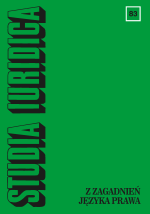Wykładniki modalności w wyrokach Trybunału Sprawiedliwości UE i Sądu Najwyższego RP – analiza korpusowa
Exponents of Modality in Judgments of the Court of Justice of the EU and the Supreme Court of the Republic of Poland: A Corpus-Driven Study
Author(s): Dariusz KoźbiałSubject(s): Law, Constitution, Jurisprudence
Published by: Wydawnictwa Uniwersytetu Warszawskiego
Keywords: modality;judgments;corpus-driven study;Court of Justice of the EU;Polish Supreme Court;
Summary/Abstract: The aim of this paper is to investigate the distribution of exponents of modality in the justifications of judgments passed by the Court of Justice of the European Union (CJEU) and judgments passed by the Supreme Court of the Republic of Poland (SN) in the post-accession period of 2011 to 2015. In particular, the paper aims to establish the degree of convergence between translated EU judgments and non-translated national judgments in terms of the employment of modality markers. The research material consists of a large corpus of Polish-language versions of 897 judgments passed by the Court of Justice (CJ), 384 judgments passed by the General Court (GC), a corpus of 2564 non-translated judgments delivered by the SN, and a reference corpus of contemporary Polish (NKJP). The quantitative data point to the high salience and divergent distribution of a number of various markers in both EU and national judgments, such as the value-laden modal verbs należy [(one) must/should] and trzeba [(one) should/must]. It is argued that the frequent use of markers of modality constitutes a generic feature, as it raises the perceived level of authoritativeness of judicial argumentation. The findings may contribute to raising awareness of language patterns which involve the expression of modal stance.
Journal: Studia Iuridica
- Issue Year: 2020
- Issue No: 83
- Page Range: 78-101
- Page Count: 24
- Language: Polish

